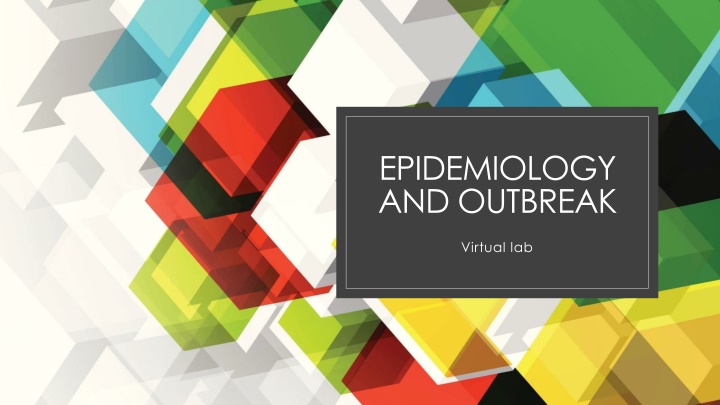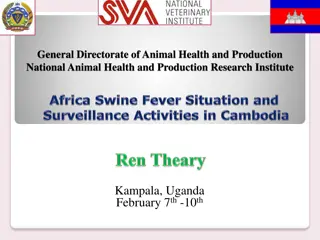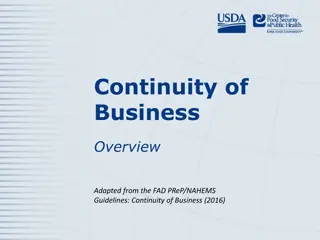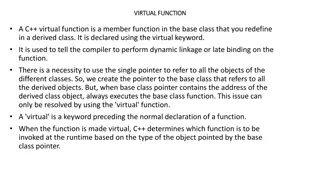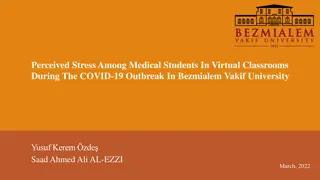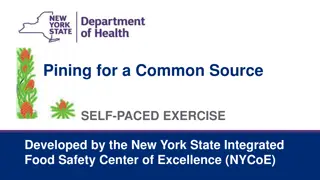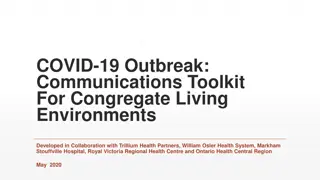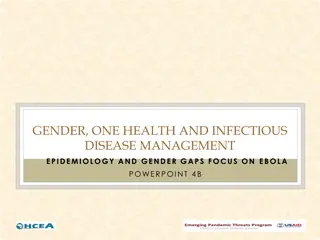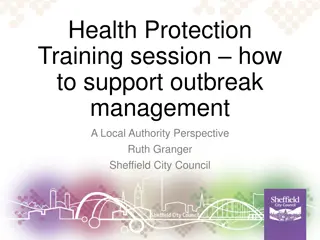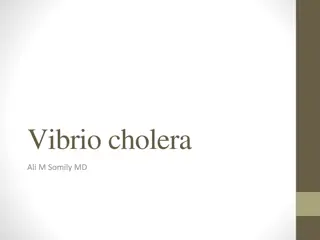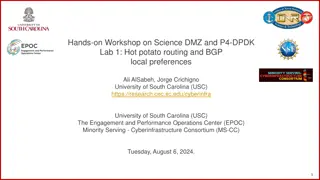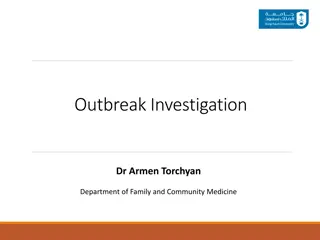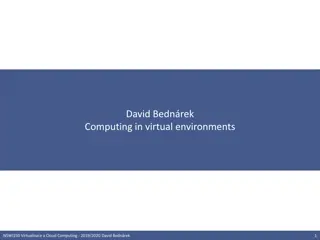Epidemiology and Outbreak Virtual Lab
Epidemiology is the study of disease frequency and distribution, encompassing surveillance, prediction, prevention, and intervention. It involves analyzing geographic patterns of disease such as endemic, sporadic, epidemic, and pandemic occurrences. Mathematical modeling helps in understanding disease spread through metrics like Ro (R-naught), indicating infection transmission rates. Ro values vary among diseases like Ebola, Influenza, Measles, MERS, Polio, SARS, Smallpox, and Coronavirus. Interpretations of Ro values provide insights into the potential impact and control of epidemics.
Download Presentation

Please find below an Image/Link to download the presentation.
The content on the website is provided AS IS for your information and personal use only. It may not be sold, licensed, or shared on other websites without obtaining consent from the author.If you encounter any issues during the download, it is possible that the publisher has removed the file from their server.
You are allowed to download the files provided on this website for personal or commercial use, subject to the condition that they are used lawfully. All files are the property of their respective owners.
The content on the website is provided AS IS for your information and personal use only. It may not be sold, licensed, or shared on other websites without obtaining consent from the author.
E N D
Presentation Transcript
EPIDEMIOLOGY AND OUTBREAK Virtual lab
Epidemiology: study of the frequency and geographic distribution of disease & health-related factors What do epidemiologists do in practice? Surveillance collect, analyze, & report data on rates of occurrence, mortality, morbidity and transmission of infections Prediction Build mathematical models that describe how a disease organism spreads through a population Prevention and Intervention Determine which diseases are Reportable , that is diseases that must be reported to state health depts, who then send quarterly reports to CDC (flu, measles are examples)
Epidemiology terms to describe geographic patterns of disease Endemic disease that exhibits a relatively steady frequency over a long period of time in a particular geographic locale. (Ex. Lyme disease in RI) Sporadic Disease that happen occasionally, with cases reported at irregular intervals. Epidemic Disease whose prevalence increases beyond what is normally expected for an area at a particular time. This may happen seasonally (e.g. the flu), or more rarely (e.g. measles) Pandemic epidemic that spreads across continents and around the world
Mathematical modeling of disease spread When a person is infected, they pass it on to at least one other individual Ro (read: R-naught or R-zero) represents the average number of new cases of infection generated by a sick or infective individual in a susceptible population. It is calculated using the formula below, where: S is the size of the susceptible population L is the length of infection, or time in during which the individual can pass on the pathogen Transmissibility ( ): is a number describing how readily the pathogen is passed from a sick to a healthy individual Ro = S*L* Note that Ro does not tell you how fast a pathogen will spread!
Important (and simple) conclusions from Ro When R0 < 1 the infection will die out in the long run But if R0 > 1 the infection will be able to spread in a population and increase over time Generally, the larger the value of R0, the harder it is to control the epidemic
Comparison of Ro values Disease Ebola, 2014 H1N1 Influenza, 2009 Seasonal Influenza Measles MERS Polio SARS Smallpox Wuhan Coronavirus 2019-nCoV Reproduction number R0 1.51 to 2.53 1.46 to 1.48 2 to 3 12 to 18 around 1 5 to 7 <1 to 2.75 5 to 7 1.4 to 4.08
Modeling disease spread Network models Are an approach to describing spreading processes such as epidemics or information transfer in populations Nodes represent individuals (circles) Edges represent interactions between individuals that could potentially lead to transmission of infection (lines) Through tracing contacts backward in time, it could show who patient zero was (? In the red circle). This is useful to understand how the outbreak began in the first place, and is essential in devising strategies to prevent or mininmize the risk of future outbreaks
Stop the spread! Important terminology Isolation Population that HAS the disease is physically isolated until healthy again. Quarantine Population that is EXPOSED is physically isolated for the estimated incubation time. In the case of COVID-19, it s about 2 weeks Social distancing Isolating to decrease the spread, especially effective for diseases that spread on cough droplets (like Coronavirus, flu, measles) Personal protection when the mechanism of spread is understood, personal protection can help enormously to slow down the spread of a disease and reduce the r0. Face masks have been shown to be very effective with COVID-19, because it spreads mainly through breath droplets. Other diseases require completely different protection. Find an example different from COVID Flattening the curve Refers to reducing the rate of emergence of new cases. This reduces the burden on hospitals to a manageable load. Think of it as spreading the cases over time. If you assume that once the pathogen is out all susceptible individuals will eventually get it, how can you slow the spread to a level that the health care system can handle? Compare the two curves at the right. The measures used are social distancing, quarantine, isolation
One Health-a comprehensive way to look at disease management 60% of human infectious diseases have come from animals We are a spillover species One Health recognizes that the health of people is connected to the health of animals and the environment collaborative, multisectoral, and transdisciplinary approach goal of achieving optimal health outcomes recognizing the interconnection between people, animals, plants, and their shared environment A One Health approach is important because 6 out of every 10 infectious diseases in humans are spread from animals. I Dilution hypothesis As biodiversity decrease, the probability increase that a disease will spill onto us rather than another animal Biodiversity IS the protector!
Factors that Affect Human and Animal Health Factor (Cause) Change (Effect) As a result, more people live in close contact with wild and domestic animals. Close contact provides more opportunities for diseases to pass between animals and people. Disruptions in environmental conditions and habitats provide new opportunities for diseases to pass to new animals and then to people. As a result, diseases can spread quickly across the globe. Human populations are growing and expanding into new geographic areas. The earth has experienced changes in climate and land use, such as deforestation and intensive farming practices. International travel and trade have increased.
Curing viral infections As you learned lecture before the break, viruses are made of only a capsid, a genome, and sometimes an envelope. They cannot reproduce or metabolize by themselves and must parasitize a cell to carry out their life cycle. This is why there are very few antiviral drugs! Since the virus exploits the cell s machinery, any drug that interferes with viral replication will very likely interefere with the life of normal, uninfected cells. Can we take antibiotics? No! Antibiotics kill bacteria and some of them fungi. All of which are cells. They won t do anything against a virus. In the long term, what s our best defense, then? Coming up with a vaccine. That will allow people s immune system to be trained to fight the virus, without going through the disease process.
First Assignment: Go to the CDC s Solve the Outbreak simulation https://www.cdc.gov/mobile/applications/sto/ Select Level 1 Complete two of the games. Answer the questions in your lab report must be typed and saved!!!!!
Second assignment: Visit the following website: http://vax.herokuapp.com/ Tour the game Complete each of the lessons Play the full game Select the Easy mode Answer the questions in your lab report must be typed and saved!!!!!
Third assignment: Read the following article: https://www.washingtonpost.com/graphics/2020/world/corona-simulator/?itid=hp_hp-top-table-main_virus- simulator520pm%3Ahomepage%2Fstory-ans Answer the questions in your lab report must be typed and saved!!!!!
